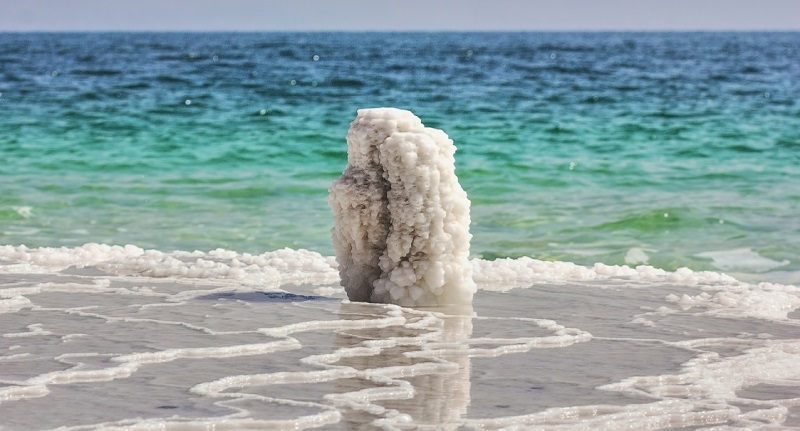Nestled between Israel, Jordan, and Palestine lies an extraordinary body of water known as the Dead Sea. Despite its ominous name, this natural wonder boasts a rich history, stunning landscapes, and unique geological features. The Dead Sea is salty, its remarkable salinity truly sets it apart. With salt concentrations more than ten times that of the world’s oceans, it ranks among the saltiest lakes on Earth. This extreme salinity results from the sea’s landlocked position and lack of outflow, causing salts to accumulate over millennia.
There are reasons behind the Dead Sea’s intense saltiness, explore its distinctive salt composition and examine how this hyper-saline environment impacts the surrounding ecosystem.
Why is it Called the Dead Sea?
The Dead Sea’s foreboding moniker stems from the inhospitable conditions that make it virtually impossible for most life forms to thrive. Its waters contain salt concentrations exceeding 33%, creating an environment too harsh for all but the most resilient microorganisms. The name also reflects the barren landscape surrounding the sea, characterized by rugged terrain and extreme aridity. Located more than 1,300 feet below sea level, the Dead Sea’s position as Earth’s lowest terrestrial point contributes to its intense heat and lack of precipitation. The combination of these factors—extreme salinity, scorching temperatures, and an arid environment—justifies its reputation as a “dead” sea in both name and nature.
Where is the Dead Sea Located?
The Dead Sea occupies a unique geological position within the Jordan Rift Valley, straddling the borders of Israel, Jordan, and Palestine. Flanked by the Jordanian highlands to the east and the Judean Mountains to the west, it sits at the heart of a massive tectonic depression. The rift valley, spanning 420 miles, marks the boundary between the African and Arabian tectonic plates. This geological formation not only created the Dead Sea but also helped contain its mineral-rich waters, preventing contamination of surrounding freshwater sources.
At 1,407 feet below sea level, the Dead Sea holds the distinction of being Earth’s lowest terrestrial point. Its location contributes to a hot, arid climate that further concentrates its salts and creates a stark landscape largely devoid of vegetation, save for a few salt-tolerant plant species.
The Dead Sea’s Salinity: Numbers and Comparison

The Dead Sea’s salinity reaches an astounding 33.7%, nearly ten times the average salinity of Earth’s oceans. This extreme concentration results from exceptionally high evaporation rates coupled with a lack of outflow, leading to the continuous accumulation of dissolved salts over time. Unlike typical seawater, which is predominantly composed of sodium chloride, the Dead Sea’s chemical makeup is uniquely diverse. It contains high levels of magnesium, potassium, and bromide ions, with sodium chloride accounting for only 10-18% of its total dissolved salts.
Each liter of Dead Sea water leaves behind approximately 250 grams of salt upon evaporation, amounting to an estimated 30 billion tons of salt throughout the entire sea. This extraordinary salinity creates an environment so hostile that it precludes most forms of life, contributing to the sea’s infamous reputation.
Why Is the Dead Sea So Salty?
The Dead Sea’s extreme salinity is primarily due to its landlocked nature and the absence of any outflow channels. Situated in an arid desert region, the sea experiences intense solar radiation, leading to rapid evaporation of its waters. As water evaporates, it leaves behind dissolved minerals and salts, which accumulate over time. The Jordan River, the Dead Sea’s primary source of inflow, also contributes minerals as it flows through salt-rich geological formations before reaching the sea. This continuous process of evaporation and mineral deposition has been ongoing for thousands of years, resulting in the sea’s current hyper-saline state.
The extreme salinity creates an environment where only the most halophilic (salt-loving) microorganisms can survive. Despite its inhospitable nature, the Dead Sea’s unique ecosystem supports a variety of extremophile bacteria and archaea, which have adapted to thrive in this challenging environment. These microscopic organisms play a crucial role in the sea’s delicate ecological balance and contribute to its distinct chemical composition.
What Lives in the Dead Sea?
Despite its reputation as a lifeless body of water, we still wonder if anything lives in the dead sea. Yes, the Dead Sea harbors a surprising array of microscopic life forms. While its extreme salinity precludes the survival of fish, aquatic plants, and most visible organisms, a hidden world thrives beneath the surface. In 2011, a groundbreaking study conducted by Israeli and German scientists revealed the presence of freshwater springs at the Dead Sea’s bottom, teeming with previously unknown microorganisms.
Although the hypersaline environment is toxic to most life forms, specialized extremophile bacteria and archaeal microbes have adapted to flourish in these harsh conditions. These resilient microorganisms have evolved unique mechanisms to cope with the high salt concentrations and intense solar radiation. Their presence demonstrates the remarkable adaptability of life, proving that even in Earth’s most inhospitable environments, specialized ecosystems can develop and persist.
Ancient Secrets of the Dead Sea
Geological studies of the Dead Sea basin offer fascinating insights into its long and complex history. Approximately 120,000 years ago, during an interglacial period preceding the last ice age, the Dead Sea experienced a complete desiccation event, leaving behind vast salt deposits. This finding, coupled with the recent discovery of freshwater springs on the sea floor, underscores the Dead Sea’s remarkable resilience and ability to recover from extreme environmental fluctuations.
Not only this, manuscripts dating back over 2,000 years were found in the 1940s and 1950s. These are the oldest known copies of biblical texts and provide valuable insights into the religious beliefs of the Essenes, a Jewish sect contemporaneous with Jesus. Here’s a complete article on why these manuscripts are important to Christianity.
The sea’s geological record serves as a valuable archive of regional climate change, preserving evidence of past rainfall patterns, seismic activity, and ecological shifts. By studying sediment cores extracted from the Dead Sea floor, scientists can reconstruct the area’s paleoclimate, offering crucial insights into long-term environmental trends and potential future changes.
Human Impact on the Dead Sea’s Size
The Dead Sea is currently experiencing a significant decline, with water levels dropping at an alarming rate of approximately 1 meter (3 feet) per year. This rapid shrinkage is primarily attributed to human intervention, particularly the diversion of water from the Jordan River for agricultural and industrial purposes. Since the early 20th century, the Dead Sea’s shoreline has receded by about 30 meters (100 feet), resulting in a dramatic reduction in its surface area.
This ongoing contraction poses severe threats to the region’s unique ecosystems. As the sea shrinks, it leaves behind expanding salt flats, altering the delicate balance of local microbial communities and endangering the rare plant and animal species adapted to this distinctive environment. The ecological consequences extend beyond the immediate vicinity of the sea, affecting migratory bird patterns and regional biodiversity.
Final Verdict
The Dead Sea stands as a testament to nature’s complexity and resilience. Its extreme salinity, resulting from its landlocked position and high evaporation rates, creates an environment that is simultaneously hostile to most life forms yet home to highly specialized microorganisms. The sea’s geological history reveals a dynamic past, marked by periods of desiccation and renewal, demonstrating its capacity to endure and adapt to significant environmental changes.
However, the Dead Sea faces unprecedented challenges due to human activities. The rapid decline in water levels threatens not only the unique ecosystems that have evolved in this harsh environment but also the geological and historical record preserved in its depths. As we continue to study and understand this remarkable natural wonder, it becomes increasingly clear that preserving the Dead Sea is crucial not only for its ecological and scientific value but also as a unique part of our planet’s natural heritage. The Dead Sea’s story is one of extremes, adaptation, and survival – a microcosm of life’s tenacity in the face of adversity.



